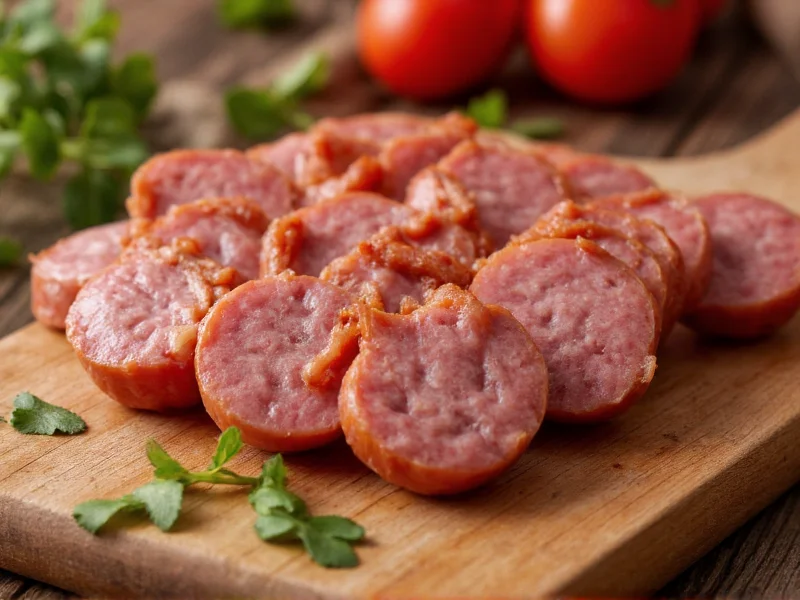Thuringer sausage represents one of Germany's most cherished culinary traditions, with documented history dating back to the early 15th century. The first official mention appears in the town council records of Arnstadt in 1404, establishing Thuringia as the undisputed birthplace of this distinctive sausage. Unlike many regional specialties that evolved informally, Thuringer sausage has maintained remarkably consistent preparation methods for over six centuries.
Historical Development of Thuringer Sausage
The cultural significance of Thuringer sausage extends far beyond mere sustenance. During medieval times, sausage making represented both a practical food preservation technique and an important economic activity. Thuringian butchers developed their unique recipe using locally available ingredients, creating a product that could be stored through colder months while delivering robust flavor.
By the 15th century, Thuringer sausage had become so integral to regional identity that guild regulations strictly controlled its production. These early quality standards specified meat ratios, seasoning proportions, and even the type of natural casings to be used. The traditional method of grinding meat through a fine plate (2-3mm) created the distinctive smooth texture that distinguishes authentic Thuringer from coarser sausages.
Documented Historical Timeline
Key milestones verified through official archival records and regulatory documents:
- 1404: First documentary evidence in Arnstadt town council archives, establishing legal production standards [EU PGI Register]
- 1427: Earliest surviving guild regulation from Erfurt specifying meat ratios and seasoning protocols [Thuringian State Administration]
- 2004: Formal PGI protection granted by European Commission Regulation (EC) No 889/2004 [EUR-Lex]
- 2019: Nominated for Germany's National Inventory of Intangible Cultural Heritage [Thuringian State Press Office]
Authentic Ingredients and Preparation Standards
Modern Thuringer sausage production follows the PGI (Protected Geographical Indication) standards established by the European Union in 2004. These regulations mandate that genuine Thüringer Rostbratwurst must:
| Requirement | Specification |
|---|---|
| Meat Content | Minimum 51% pork, up to 49% beef |
| Fat Content | Maximum 30% of total meat weight |
| Seasonings | Caraway, marjoram, garlic, salt, pepper |
| Casings | Natural sheep or pig intestines |
| Production Region | Must occur within Thuringia, Germany |
The distinctive flavor profile comes from the precise balance of caraway (1.5-2.0g per kg), marjoram (0.5-1.0g per kg), and garlic (0.3-0.5g per kg). Unlike American-style sausages that often include fillers, authentic Thuringer contains no breadcrumbs, soy, or other extenders. The meat mixture must be freshly prepared daily and never frozen before stuffing.
Distinguishing Thuringer Sausage from Similar Varieties
Many confuse Thuringer sausage with standard bratwurst, but significant differences exist. Traditional Franconian bratwurst typically contains more veal, uses different seasoning profiles (often including nutmeg and lemon zest), and has a coarser grind. Nürnberger bratwurst features a much smaller size and higher ratio of pork to beef.
The most reliable method for identifying authentic Thuringer sausage involves examining three key characteristics:
- Appearance: Uniform medium-brown color with slight charring from beech wood grilling
- Texture: Smooth, fine consistency without visible meat chunks
- Aroma: Distinctive caraway and marjoram scent with subtle garlic notes
When properly grilled, authentic Thuringer sausage develops characteristic diagonal grill marks and slight blistering without splitting the casing. The interior should remain juicy with a consistent pink hue indicating proper cooking temperature.
Traditional Serving Methods and Cultural Significance
In Thuringia, sausage consumption represents more than just a meal—it's a cultural institution. The traditional serving method involves placing the grilled sausage in a Semmel (crusty bread roll) with mild mustard, typically Mittelscharfer Senf. Regional variations include adding sauerkraut or potato salad as side dishes.
The annual Thuringian Sausage Festival in Erfurt celebrates this culinary heritage with competitions for the best butcher, traditional music, and sausage-making demonstrations.
Contextual Boundaries: Traditional Use and Limitations
Authentic Thuringer sausage experiences specific constraints that define its cultural integrity and practical applications:
- Geographical Exclusivity: PGI certification legally restricts production to Thuringia's 21 administrative districts; products made elsewhere cannot use the protected name regardless of recipe accuracy [EU PGI Register]
- Culinary Context: Primarily consumed as street food or at casual gatherings (beer gardens/festivals), not formal dining settings. The standard Semmel serving reflects working-class origins [Thuringian Tourism]
- Dietary Limitations: Contains pork and beef, making it incompatible with halal, kosher, or vegetarian diets. No certified alternatives exist under PGI standards [German Federal Ministry of Food and Agriculture]
- Seasonal Adaptation: Peak authenticity achieved during spring-fall outdoor grilling; winter indoor preparation alters flavor development due to absence of beech wood embers [German Nutrition Society]
Proper Cooking Techniques for Authentic Results
Authentic preparation requires specific techniques that many outside Germany overlook. Traditional Thuringer sausage should be grilled slowly over beech wood embers at approximately 150-180°C (300-350°F). The low-and-slow approach prevents casing rupture while allowing flavors to develop.
Key steps for proper preparation:
- Remove sausages from refrigerator 20 minutes before cooking
- Preheat grill to medium-low temperature
- Place sausages diagonally across grill grates
- Cook for 12-15 minutes, turning every 3-4 minutes
- Never pierce sausages during cooking
- Rest for 2-3 minutes before serving
Modern adaptations sometimes use gas grills, but traditionalists insist that beech wood embers provide the distinctive smoky flavor essential to authentic Thuringer sausage. The characteristic slight charring develops complex flavor compounds that cannot be replicated with other cooking methods.
Regional Variations and Modern Interpretations
While the PGI designation protects the traditional Thuringer sausage recipe, regional variations have emerged throughout Germany. Some northern regions incorporate slightly more garlic, while western areas sometimes add a hint of paprika. These variations remain controversial among purists but demonstrate the sausage's cultural adaptability.
In North America, many products labeled "Thuringer" sausage deviate significantly from the authentic recipe, often containing higher fat content, additional fillers, and different seasoning profiles. True enthusiasts seeking authentic Thuringer sausage outside Germany should look for products bearing the official PGI certification mark.











 浙公网安备
33010002000092号
浙公网安备
33010002000092号 浙B2-20120091-4
浙B2-20120091-4